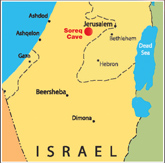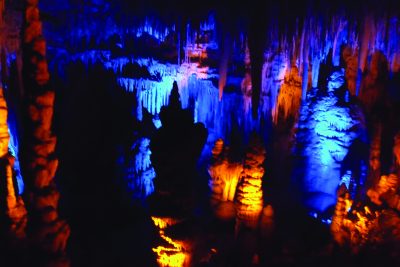×


We have detected your country as:
Please click here to go to the USA website or select another country from the dropdown list.
by: Kathy DeGagné, BFP Staff Writer
One of the wonders of Israel is its caves hidden deep below the surface of the Judean Mountains. The largest, Soreq Cave, was accidentally discovered in 1968 when some blasting in a nearby quarry revealed an opening in the side of a mountain. Beneath it was a cavern rich in stalagmites and stalactites—a living, growing collection of amazing limestone structures.
 Soreq Cave is located on the southern slope of Mount Yaela which offers spectacular views of the coastal plain to the west, and the Elah Valley to the south. The cave is the main feature of the Stalactite Nature Reserve, located 20 km (12 miles) southwest of Jerusalem. On our way to visit the cave, we drove through the beautiful, wooded Jerusalem Hills, along a high winding road, past picnic groves, scenic outlooks, and archeological sites. Getting there was as much a highlight as our final destination itself.
Soreq Cave is located on the southern slope of Mount Yaela which offers spectacular views of the coastal plain to the west, and the Elah Valley to the south. The cave is the main feature of the Stalactite Nature Reserve, located 20 km (12 miles) southwest of Jerusalem. On our way to visit the cave, we drove through the beautiful, wooded Jerusalem Hills, along a high winding road, past picnic groves, scenic outlooks, and archeological sites. Getting there was as much a highlight as our final destination itself.
After clambering down the side of the mountain on well-spaced steps (we counted 208 of them!) to reach the cave entrance, we entered the underground cavern and the sight was extraordinary. Beautiful colored lighting illuminated spectacular rock formations, formed by thousands of years of dripping rainwater slowly dissolving limestone rock, and then crystallizing again to form stalactities and stalagmites. That’s the millennia-long process simplistically described in one brief sentence.

Kathy DeGagné/ Bridges for Peace
It’s hard to believe that a drop of water can dissolve rock, and even harder to believe that it can create a massive chamber beneath a mountain. But Rabbi Akiva, the beloved and heroic Jewish scholar, apparently understood the power of a drop of water. After living his first 40 years as an unschooled shepherd, he realized, if a drop of water could wear down rock, then he could learn to read. And that’s what he did, to the lasting benefit of the entire Jewish world.
Back in the cave, the humidity was high and, in the quiet, we could hear the constant drip, drip, drip echoing through the chamber, the water droplets going about their unending work of creativity. Curtains of stalactites screened parts of the cave from sight, but as we meandered on the serpentine walkways slightly suspended above the cavern floor, dozens of amazing shapes emerged from the shadows on every side, formations whimsically dubbed “Elephant Ears,” “Snow White and the Seven Dwarfs,” and “Unrequited Love” to name just a few. Soreq Cave isn’t large by world standards, but the natural treasures it contains would rival any cave in the world.
All logos and trademarks in this site are property of their respective owner. All other materials are property of Bridges for Peace. Copyright © 2025.
Website Site Design by J-Town Internet Services Ltd. - Based in Jerusalem and Serving the World.